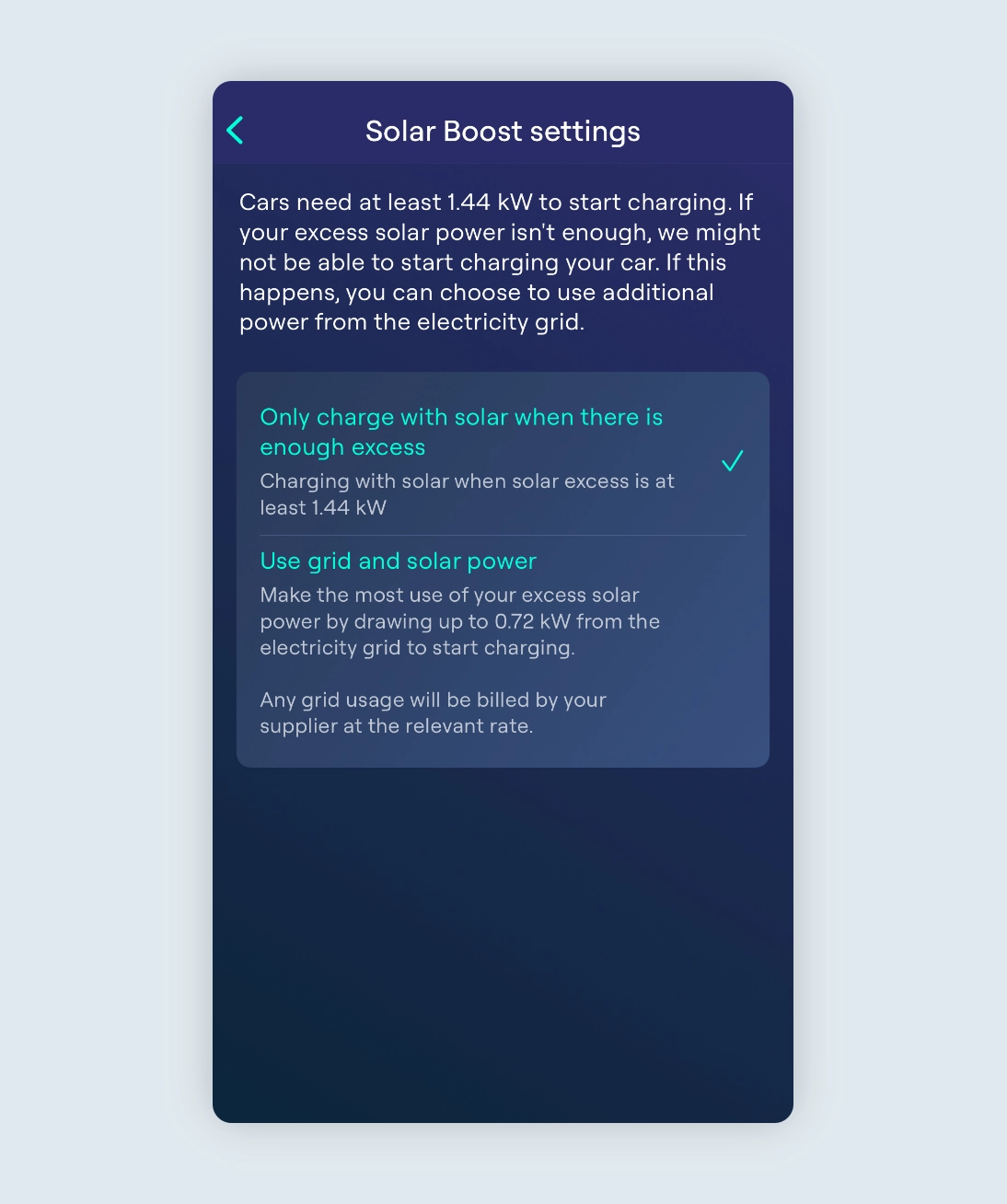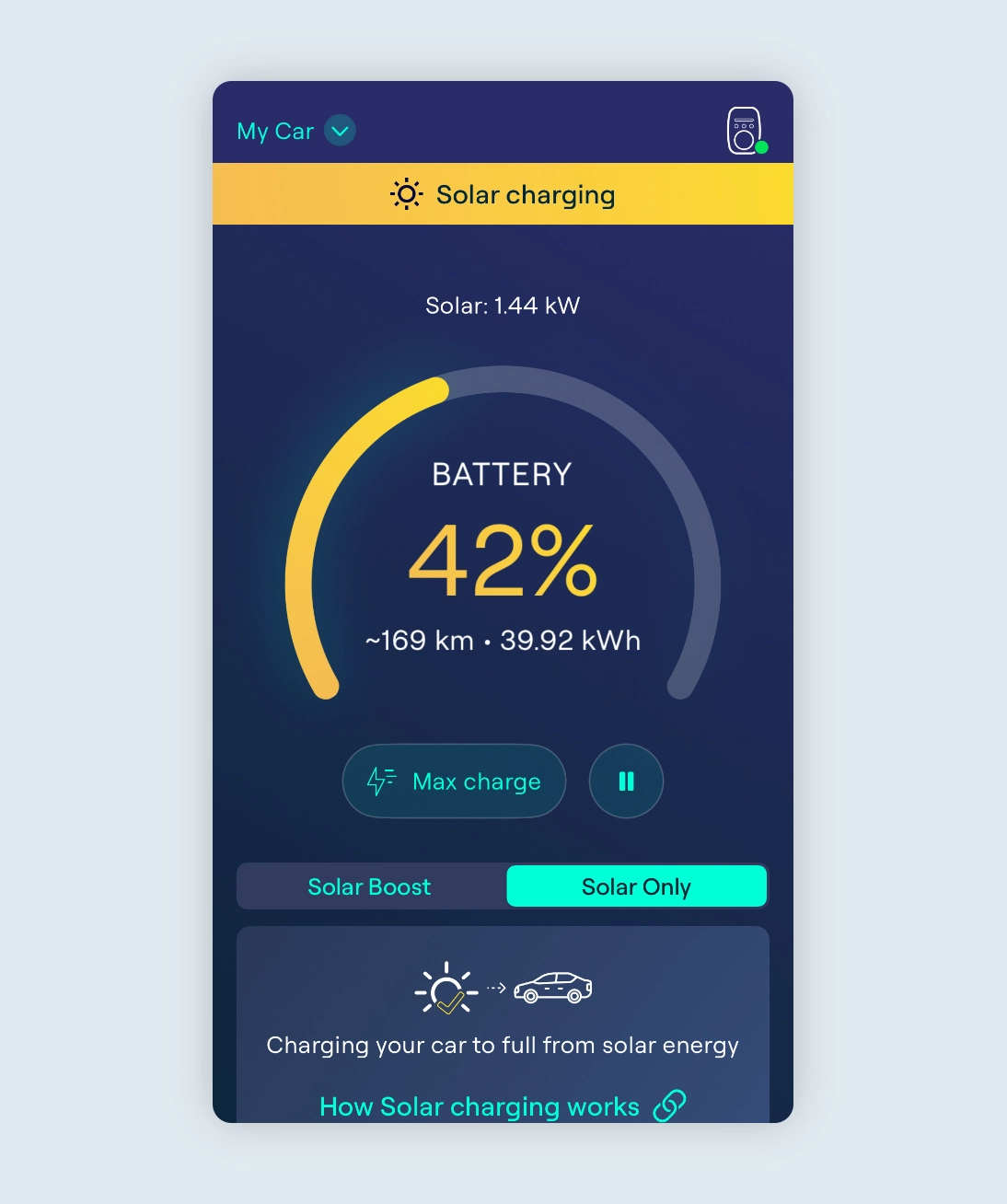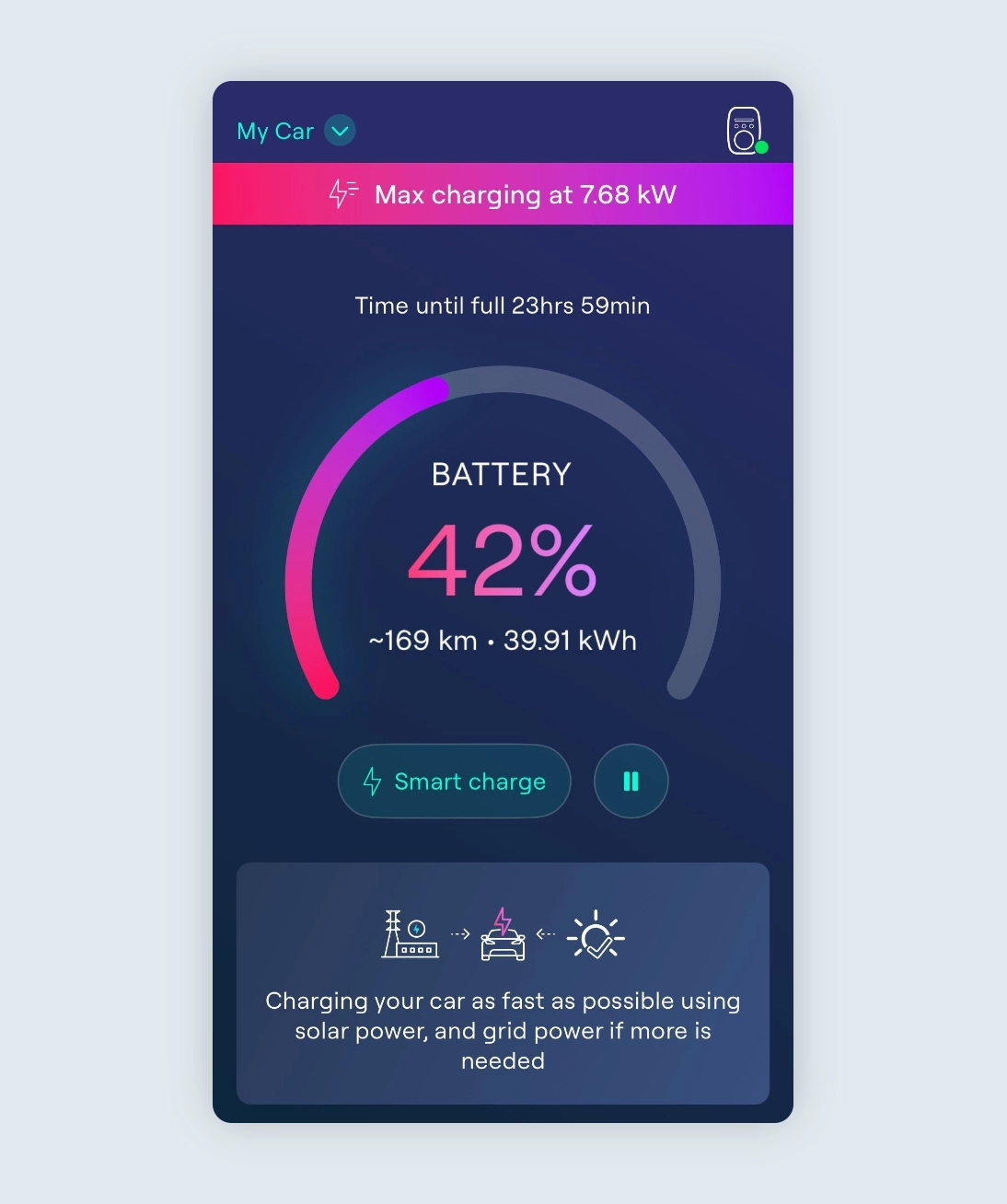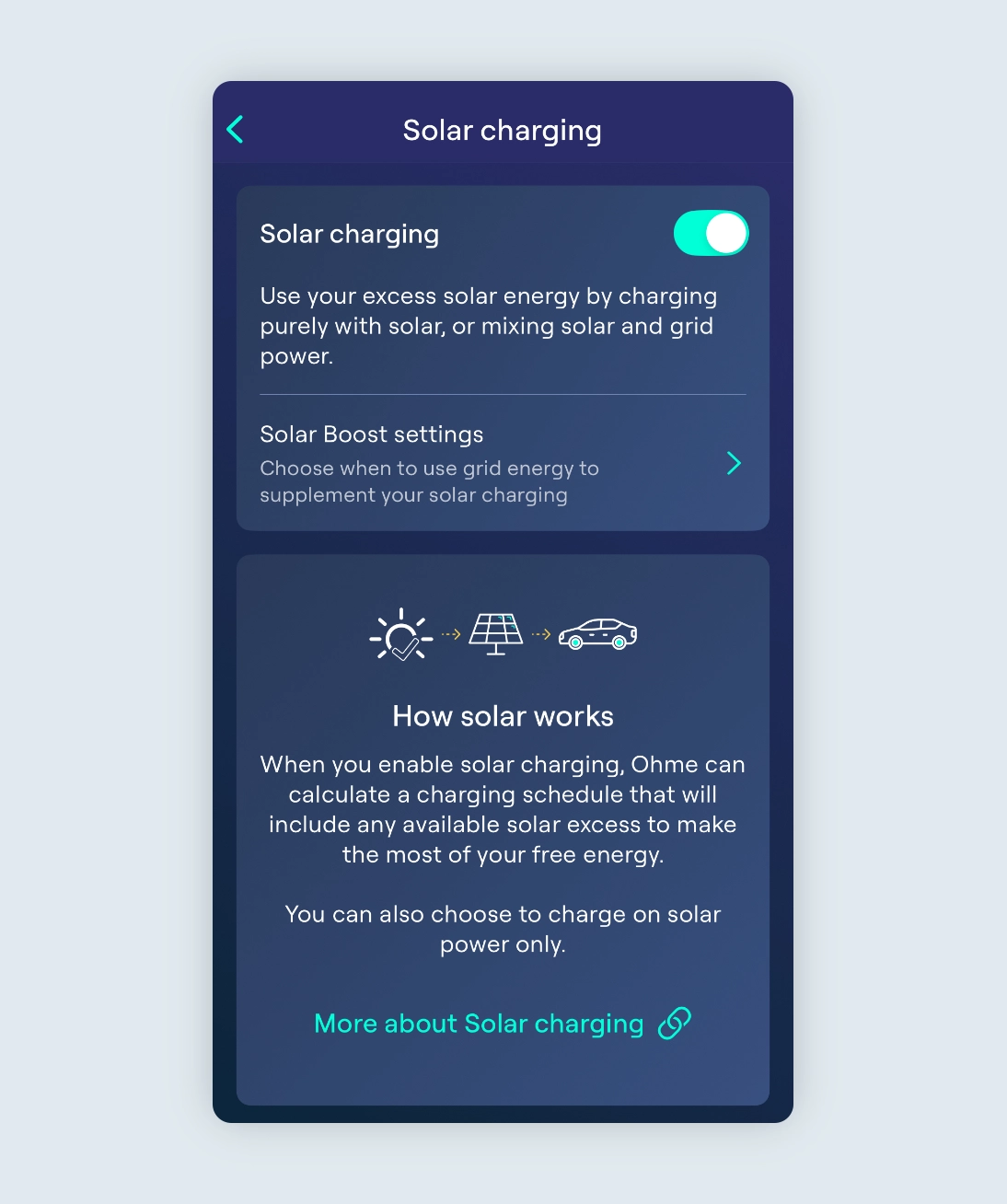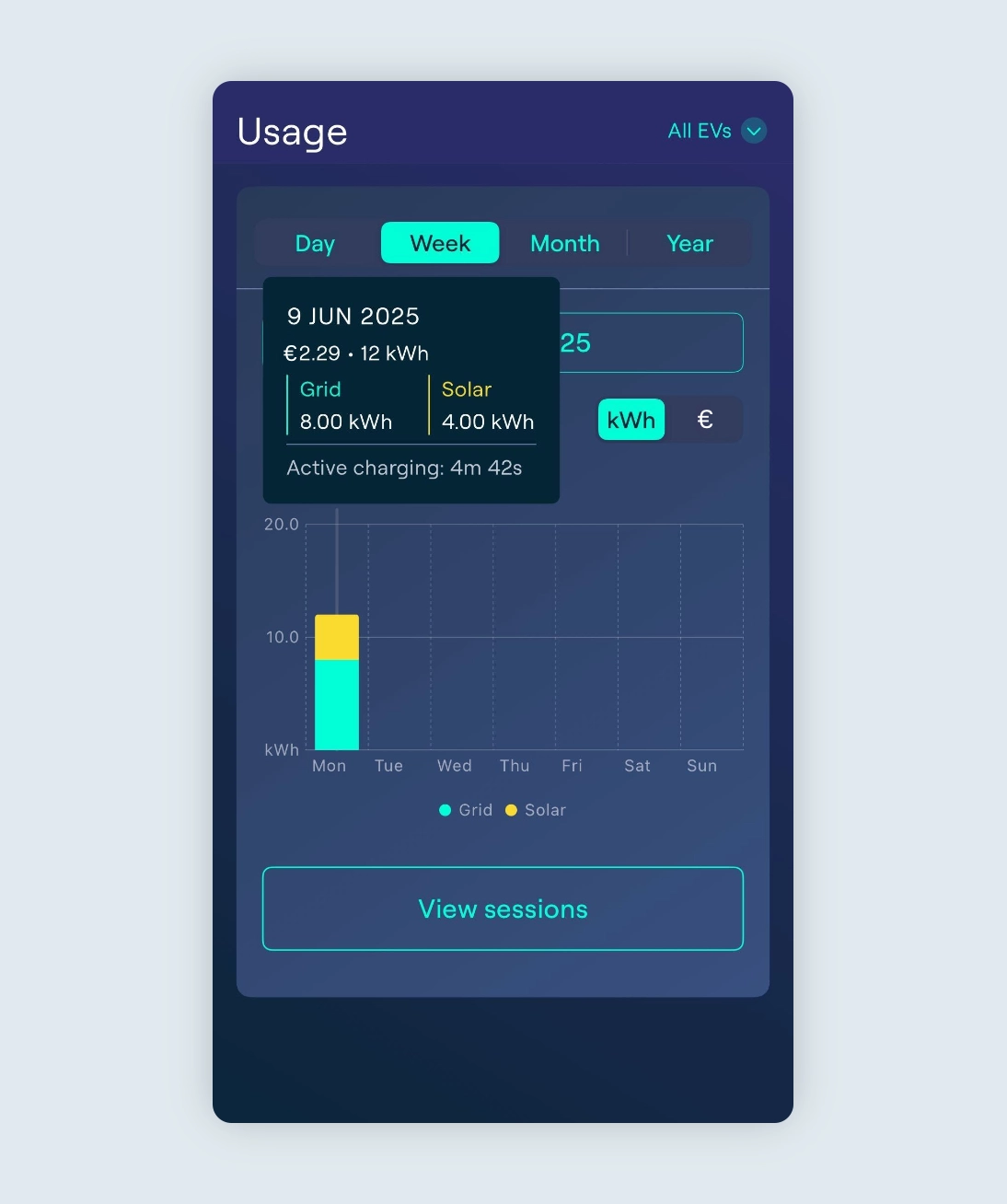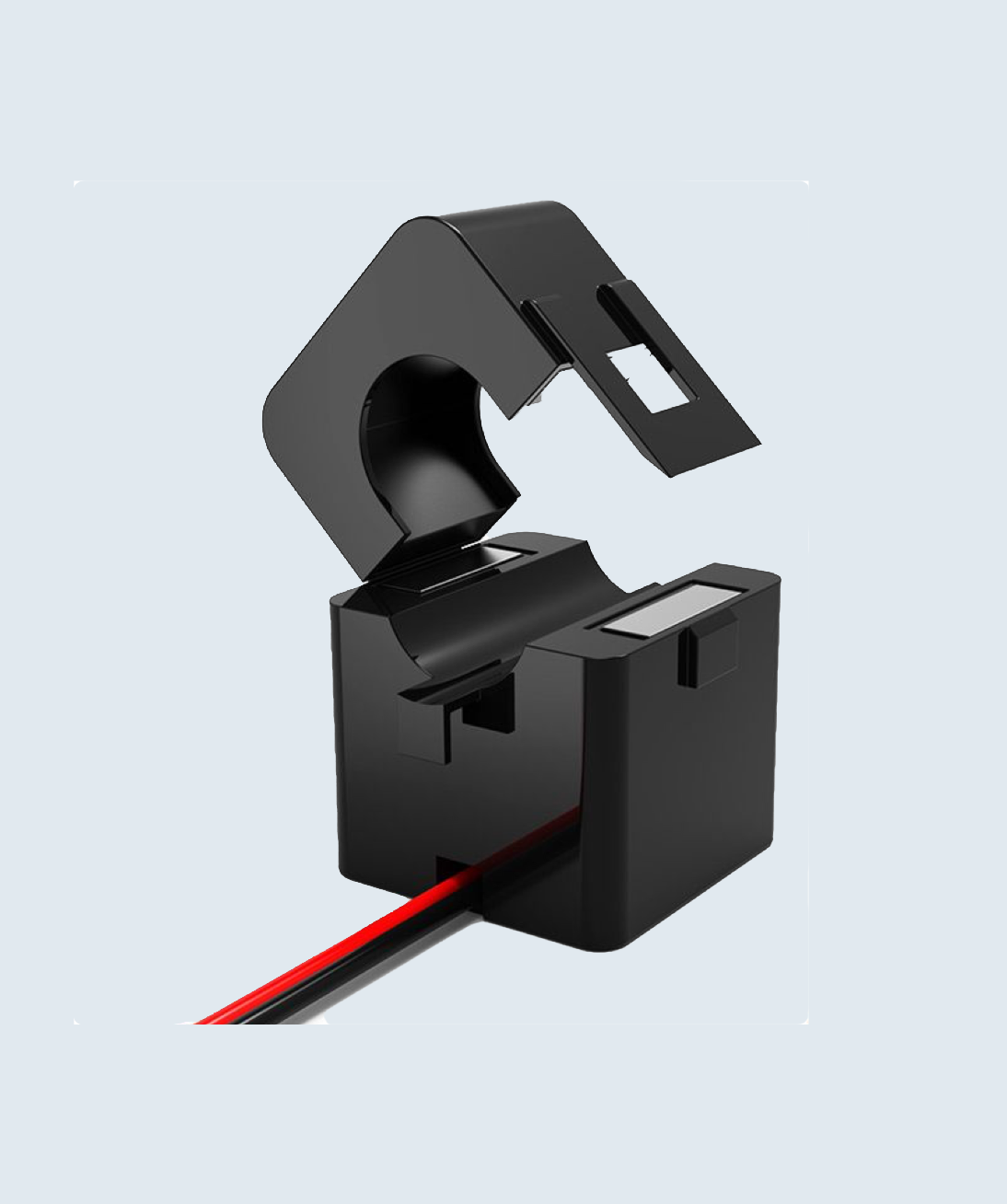Please note: App verison 2.10.0 or later required.
Charging your car using solar power is a great way to save money and reduce your carbon footprint. When there is enough excess solar power, Ohme can use this to charge your EV, helping you make the most of your self-generated green energy. This article explains the solar charging features available in the Ohme app, how to use them, and eligibility requirements.
Jump to:
Am I eligible for solar charging?
How can I charge with solar in the Ohme app?
What are Solar Boost and Solar Only?
What happens if solar power stops being generated during charging?
How to set up solar charging in the Ohme app
Solar savings
What can I do if I’m not eligible?
FAQs
Am I eligible for solar charging?
Solar charging is available for most Ohme Home Pros and Ohme ePod chargers with a recent and complete setup installed from January 2023 onwards.
Please note: if you are not on a single-rate electricity tariff, setting up solar charging will require careful consideration of Solar Boost settings to avoid consuming higher-cost grid electricity. For example, customers on a dual or multi-rate tariff should to consider all options given it may be cheaper to only charge at night when electricity rates are lower. Find out more about the settings available here.
Not eligible?
If you cannot see an option to toggle solar charging on or off in the Settings screen, this indicates you are not eligible for this feature at this time. The most common reasons are that the charger was installed before January 2023, or that a CT clamp is either not installed or not providing a reading.
Please read the information below for guidance on what to do if you are not eligible.
How can I charge with solar power in the Ohme app?
The Ohme app offers two solar charging options, Solar Boost and Solar Only, so you can choose how much solar energy and grid energy you use to charge your EV. Each option is designed for a different approach:
- Solar Boost – prioritises reaching your set charging target, using both solar and grid power as needed, but maximising the use of any excess solar power available.
- Solar Only (coming soon) – prioritises using excess solar power to charge your EV, keeping grid power to a minimum. With Solar Only grid power will be used for ~15 seconds at times solar power is interrupted, before stopping the charge.
What are Solar Boost and Solar Only?

Solar Boost
Solar Boost is a solar charging option that offers a mix of solar and power from the grid.
When Dynamic charging is enabled:
You can set a target for how much you want your EV to be charged and the time you need it to be ready. Ohme will create a charging schedule to meet your target on time. Throughout the session, any excess solar power can be used to top up your car, even outside the scheduled grid charging times. After your target is reached, Ohme will continue to use available excess solar power to keep charging your EV while it is plugged in.
When Dynamic charging is off:
Ohme will charge your EV to full as quickly as possible, up to the maximum speed your car allows. This is usually up to 7kW for most EVs or 3.5kW for some hybrids but could be up to 11kW for 3-phase chargers and compatible EVs. If you have set a Price cap, Ohme will charge as much as possible with grid power within the available times and will stop when the battery is full. Any extra solar power you generate can be included at any time to reduce the overall grid power required.
Note: This Charge screen layout appears if Ohme is not set up to read your EV’s battery status. You will see the total amount of energy added during the session.
Solar Boost settings
To begin charging your EV, at least 1.44kW (6A) of power is required. Since home solar systems can sometimes generate less than that, you have two options for how Ohme manages your excess solar and grid power:
Only charge with solar power when there is enough excess:
Ohme will wait until at least 1.44kW of excess solar power is being detected before charging starts outside of scheduled times.
Use grid power and solar power:
Ohme can start charging when at least 0.72kW of solar power is detected and matches it with up to 0.72kW of grid power to reach the minimum charge rate the EV will accept before charging starts outside of scheduled times.
Note: If your solar system is producing more than 1.44kW, Ohme will use all the available excess solar power, no grid power will be needed.
Note: One of the modes must be selected, and this setting applies only to the Solar Boost option. Any grid energy used will be billed at your energy supplier’s rates at the time of charging. Depending on your charger model or firmware version, you may only have one option available. For example, 3-phase chargers only display the option to charge when there is enough excess solar power. Some chargers may not be eligible for a firmware upgrade to enable both options.
Solar Only (coming soon)
Solar only is a simple way to charge exclusively with excess solar energy, whenever it is available. Setting a target or ready by time isn’t available for this option, so no schedule will be created. Ohme will start charging your car when at least 1.44kW of excess solar power is available.
Note: This Charge screen layout will be shown for EVs where Ohme is set up to retrieve the battery status. You will see the battery indicator and percentage shown, and Ohme will check in with the EV every so often to update the battery level.
Charging with a price cap
If you have a dual or multi-rate tariff, where you pay different rates for electricity at different times of the day (like cheaper night rates), you may wish to make use of solar power during the day with Ohme scheduling the bulk of the charging within your off-peak period. Charging will only start outside these hours if excess solar power is available.
To do this, ensure the Price Cap is enabled, which means Ohme cannot schedule charge when electricity is at a higher cost than your cap. Simply plug in your vehicle during the day and Ohme will schedule charging during the off-peak hours of your tariff.
Max Charging
If you wish to charge the vehicle to full as soon as possible, you can initiate a Max Charge and Ohme will deliver the maximum charging rate that your vehicle can accept until your EV battery limit is reached. If there is any excess solar power, this will be used to reduce the amount drawn from the grid while maintaining the maximum charging rate.
What happens if solar power stops being generated during charging?
If solar power drops below the level needed to continue charging, Ohme will keep charging at the same rate using only grid power for 15 seconds. After 15 seconds, charging will pause for 5 minutes. Charging will automatically restart once your selected Solar Boost settings are met again. For example, if you chose the option to allow grid power at 0.72kW, charging will resume as soon as at least 0.72kW of solar power is being generated. If you set your charger to only use solar power when there is at least 1.44kW, Ohme will wait until enough solar power is being generated before starting again.
If you are using the Solar Boost mode and have set a specific target for Ohme to reach – this will be achieved with a scheduled charge. If excess solar power is available before or during scheduled times, the session will be recalculated to take that into account and reduce the amount of scheduled grid usage accordingly. So for example, if your minimum target is 60%, we could charge to 60% using any or both sources, and then up to 100% using only solar power.
How to set up solar charging in the Ohme app
- In the Ohme app, go to Settings > Charging settings > Solar charging, then tap the toggle to switch on.
- If more than one Solar Boost setting is available, you will need to select your preferred option:Only charge with solar when there is enough excess
Wait until 1.44kW (6A) of solar power is detected before charging.
Use grid and solar power
Allow Ohme to start charging with as little as 0.72kW of solar power is detected and make up the rest with grid power to meet the EV’s minimum charging rate of 1.44kW (6A).
- On the Charging screen, you can choose between Solar Boost or Solar Only before or after you plug in.
Solar savings on the Usage screen
Once your charging session is finished, the Ohme app will show you an estimate of how much grid electricity you avoided and how much you saved by using solar power. Make sure your tariff details are up to date in the app for the most accurate information. Learn how to keep your tariff up to date in our help article, here.
What can I do if I’m not eligible?
We appreciate your interest in our solar charging feature. However, certain requirements need to be met for the feature to function properly. If you’re finding that you’re not eligible, it could be due to one of the following reasons:
Older chargers
If your charger was installed prior to January 2023, it may not contain the necessary components required for the solar charging feature to work. The technology required for this feature was not standard in chargers installed before this date.
No CT clamp installed
A CT (Current Transformer) clamp is a crucial component for the solar charging feature. While it’s not a requirement for charging, it is essential for Ohme to charge with solar power. If your installation does not have a CT clamp, you will need to have one fitted.
- The CT clamp will need to be located on a live cable as close to the meter box as possible.
- Install close to the electricity meter, around the incoming live cable
- The arrow pointing in the direction of electricity going to the house (away from the source of electricity)
- Ensure the clamp is properly closed and locked shut
If you find that your system falls into one of these categories, please contact your installer to discuss potential upgrades or modifications to be compatible with the solar charging feature. We’re committed to helping you transition to this innovative and sustainable energy solution.
FAQs
How does the Solar Boost feature work with my battery system?
Ohme chargers can’t tell where your electricity is coming from, so if your home battery is set to discharge while your EV is plugged in, Ohme may use power from the battery. To prevent this, set your home battery not to discharge when using this feature.
Why is Ohme using so much power from the grid?
Solar Boost is enabled and a charge schedule has been created:
- When Solar Boost is set to use both solar and grid power, Ohme will use grid power to meet your scheduled target, especially if your solar generation is low. This can result in charging at the maximum rate, like 7kW, to make sure your target is met on time.
To fix this:
If you only want to charge with solar power, switch to Solar Only. This way, Ohme will wait for sufficient solar power and won’t use grid power to reach a schedule.
- Your Solar Boost setting allows grid top-up:
If your Solar Boost setting is set to allow grid power to help reach the minimum required for charging, Ohme will always use some grid power whenever solar power alone isn’t enough.
To fix this:
Check your Solar Boost settings and, if available, set it to only allow charging when there is enough excess solar power.
How much energy will come from the grid?
The amount of grid energy used depends on the solar charging option and Solar Boost settings you select. With Solar Boost, Ohme uses a mix of solar and grid power to reach your chosen target and ready by time, using more grid energy if solar generation is low. If you select the “Use grid and solar power” setting, charging can begin with as little as 0.72kW of solar power, topped up with up to 0.72kW of grid power. If you choose “Only charge with solar when there is enough excess,” charging will only start when your solar generation reaches at least 1.44kW, and no grid energy will be used outside scheduled targets. With Solar Only, charging only happens when there is at least 1.44kW (6A) or excess solar power, so no grid energy will be used.
Solar Boost
|
✅ Scheduled charging can use grid power
✅ Unscheduled charging can use grid power
☀️ Solar charging starts if more than 3A of solar is available. Any extra power needed will come from the grid (no matter your price cap).
|
✅ Scheduled charging can use solar power only
❌ Unscheduled charging cannot use grid power
☀️ Solar charging starts if more than 6A of solar is available. No grid power will be used.
|
Solar Only (coming soon)
|
–
|
❌ Scheduled charging will not use grid power
❌ Unscheduled charging cannot use grid power
☀️ Solar charging starts if more than 6A of solar is available. No grid power will be used.
|
How will the number of solar panels I have affect the charging of my car?
A collection of solar panels is referred to as an “array”. Typically, a larger array will provide more solar power, and therefore require less grid energy to charge your car. It will depend, however, on the battery capacity of your EV – a larger battery will take longer to charge from a small array versus a larger one. Generally speaking, a solar array of between four and ten panels is sufficient to generate enough electricity to charge the average EV without drawing a single watt-hour from the grid.
Why has Ohme exceeded my target percentage?
When charging with Solar Boost, Ohme keeps track of how much solar energy is being used and will adjust the charging schedule to use less grid power whenever possible. The aim is to maximise the use of excess solar power to charge your car. Sometimes, this means your car might be charged a bit more than your set target, but Ohme will never go above the battery limit you have set in your car’s settings.

